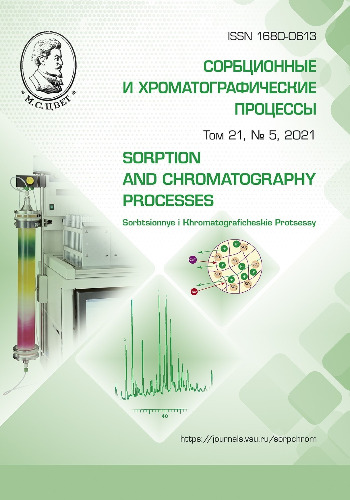Study of the sorption properties of zeolite-containing tripolite from the Khotynets deposit in the Orel Region
Abstract
The purpose of the study was to evaluate the possibility of using zeolite-containing tripolite from the Khotynets deposit of a specific mineral composition for purification of ground and surface waters from anthropogenic Ni2+ and Zn2+ and as a geochemical barrier. We studied the sorption and filtration properties of zeolite-containing tripolite samples with a pre-determined mineralogical and chemical composition in accordance with known GOST standards and industry methods. The total cation exchange capacity of the studied zeolite-containing tripolite samples was determined by the ammonium ions. It amounted to 1.53 meq/g. The kinetics of sorption of the above ions from solutions of different mineralisation (0.003 N CaCl2 and 0.06 N CaCl2) was studied by the limited volume method. Taking into account the equilibration time, we obtained isotherms of Ni2+ and Zn2+ sorption by zeolite-containing tripolite from 0.003 N CaCl2 and 0.06 N CaCl2 solutions. In the range of the studied concentrations of pollutant ions (2-10 mg/dm3), the isotherms of sorption of Zn2+ and Ni2+ were linear. We studied the sorption of nickel and zinc ions depending on the pH. It was determined that at рН=6, the sorption of Ni2+ from 0.003N CaCl2 decreased by 23%, and the sorption of Zn2+ decreased by 13%. At the same time, it was shown that after 3 weeks of solution contact with an initial pH=6.7, the equilibrium pH increased to 7.7-7.8. It may be due to the presence of other minerals (calcite, cristobalite, smectite, etc.) in the initial rock. The filtration rate decreased approximately 4 times in 5 months. The data obtained allowed us to conclude that the studied zeolite-containing tripolite of the known mineralogical and chemical composition could be used to solve environmental problems (purification of surface and ground water of low mineralisation (0.003 N) from Ni2+ and Zn2+ ions).
Downloads
References
Nikashina V.A., Sorbtsionnye i khromatograficheskie protsessy, 2019, Vol. 19, No 3, pp. 289-304. https://doi.org/10.17308/sorpchrom.2019.19/746
Lygina T.Z., Mikhailova O.A., Naumkina N.I., Gubaidullina A.M.et al., Georesursy, 2015, Vol. 1, No 4(63), pp. 56-61.
Ivanov M.G., Likhareva O.B., Matern A.I., Iaroshevskaia Kh.M., Vestnik Kazanskogo Tekhnologicheskogo Universiteta, 2014, Vol. 17, No 7, pp. 54-59.
Fominykh I.M., Galkin Yu.A., Nikiforov A.F., Anikin Yu.V. et al., Izvestiia Chelia-binskogo nauchnogo tsentra, Khimiia i bi-oekologiya, 2006, No 1 (31), pp. 67-70.
Nikiforov A.F., Baranova O.Yu., Anikin Yu.V., Kutergina I.N. et al., Sorbtsionnye i khromatograficheskie protsessy, 2006, Vol. 6, No 6, pp. 928-931.
Khuramshina I.Z., Nikiforov A.F., Lipunov I.N., Pervova I.G., Sorbtsionnye i khromatograficheskie protsessy, 2014, Vol. 14, No 2, pp. 338-344.
Grushicheva E.A., Bogdanovich N.G., Emelianov V.P., Petrukhina G.N. et al., Sorbtsionnye i khromatograficheskie protsessy, 2006, Vol. 6, No 6, pp. 922-927.
Iurmazova T.A, Shakhova N.B., Chan Tuan Khoang, Plankina M.V., Izvestiia Tomskogo politekh. universiteta. Inzhiniring georesursov, 2018, Vol. 329, No 5, pp.125-134.
Anisimov V.S., Petrov K.V., Ratnikov A.N., Voda: khimiia i ekologiia, 2009, No 10, pp. 11-16.
Grigoreva A.V. Dissertatsiia na soiskanie uchenoi stepeni k.g-min.nauk. M. 2002. 90 p.
Gribanov E.N., Oskotskaia E.R., Saunina I.V., Sorbtsionnye i khromatograficheskie protsessy, 2018, Vol. 18, No 3, pp. 316-323.https://doi.org/10.17308/sorpchrom.2018.18/534
Saunina I.V., Gribanov E.N., Oskotskaia E.R., 11-aia Vserossiiskaia konferentsiia po ana-lizu obieektov okruzhaiushchei sredy s mezhdunarodnym uchastiem «EKOANALITIKA-2019», 2019, pp. 151.
Gribanov E.N., Sorbtsionnye i khromatograficheskie protsessy, 2020, Vol. 20, No 6, pp. 719-725.
Glushankova I.S. Dissertatsiya doktora tekh. nauk., Perm, 2004, 331 p.
Instruktsiia № 24. Opredelenie ionoobmennoi emkosti tseolitsoderzhashchei poro-dy po pogloshchennomu ammoniiu". 1993. Otraslevaia metodika. Novosibirsk. 18 p.







